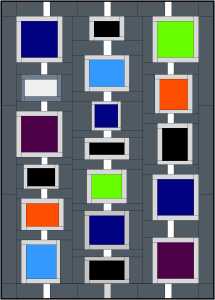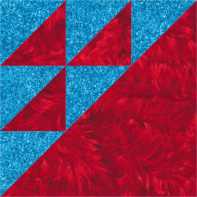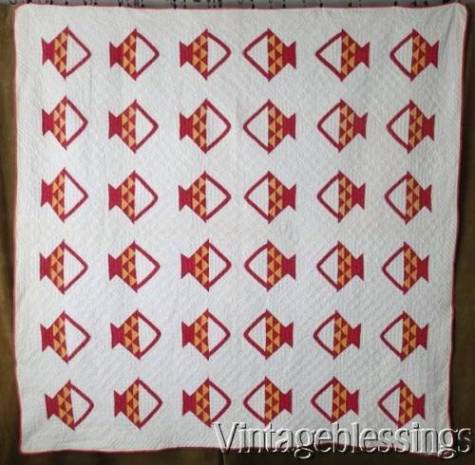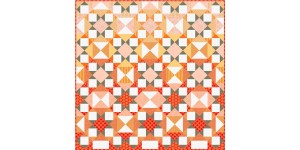Hello, do you remember me? I know I’ve been gone for awhile, but I am back now. I plan on getting caught up with lots of ideas and enthusiasm for quilts and sewing! My camera is full of the projects which I plan on blogging about and I just need to sit down and write. School will be starting soon here in the United States and the weather will be getting colder. My youngest will be starting his senior year in high school (where did all the time go?). It is time to plan his ‘graduation’ t-shirt quilt. I have been faithfully collecting the out-grown t-shirts in a box under my longarm. Over the next few months I will walk you thru my T-shirt quilt creation process.
Step one: Collect T-shirts. When my niece was a senior, several years ago, I offered to make a quilt for her. Her mom and grandmother gave me a series of t-shirts from her high school theater productions (they brought over a stack of neatly laundered and ironed t-shirts!). Collecting t-shirts around a theme helps to make the quilt more cohesive. Themes can be narrow, e.g. marathons, baseball, theater, band, scouts, etc., or they can be broad, e.g. school activities, family vacations, etc. Sometimes I just collect them around a color, or I just empty the collecting bin.

Step two: Cut, fuse, and trim the t-shirts. First, I cut the front of the t-shirt away from the back and roughly trim it so that there is at least an inch or two away from the design. At this point I can tell if all of the t-shirts will trim down to the same size (rare) or multiple sizes (the norm). Then I fuse the t-shirts onto French fuse (tricot fusible) or a light weight fusible interfacing. If I use the tricot fusible I make sure that stretchiest direction of the fusible is fused to the least stretchy direction of the t-shirt. Thus, making the t-shirt less stretchy in all directions. Lastly, I trim the t-shirts to their finished size plus 1/2 in (seam allowance).
Step three: Edit. I decide which t-shirts will appear on the front of the quilt, and if I have too many, which will appear on the back of the quilt. At this point, I interview the recipient–which t-shirts are the most important? what designs do they like: traditional, modern, regular, irregular; what colors do they like? etc. I like to place their name on the front of the quilt in some way, either with a t-shirt, appliqued or embroidered.

Step four: Design. My niece wanted a ‘modern’ quilt with grays/blacks as the background. I used google to search ‘modern design’ and found images of modern designs. I thought that this type of design would be perfect for my niece. I designed each block in EQ7 and then arranged them in a quilt. I made sure that the quilt was going to be the right size for her college dormitory (extra long twin)

Step five: Piece the quilt top and the back. Using my EQ7 design, I cut background fabric and pieced together the blocks of the quilt. The back of the quilt is a good place to put leftover blocks and fabric.

Step six: Quilt as desired. I always keep in mind that these quilts are loved and laundered frequently. I like to quilt them at least every inch and use good thread so that they will stand up to all of the love–these are probably not the quilts to use heirloom custom quilting on. My oldest son’s t-shirt quilt, which was tied, not quilted made it through 4 years of college…barely.
Step seven: Bind. Make sure that your binding is sturdy and sewn on well because it is the part of the quilt which gets the most use.
Step eight: Label. Unfortunately, my photo does not show my writing on the label, but it is there–my name, the date made, place made and why I made the quilt.

Step nine: Give it to the happy recipient.

I look forward to working on my son’s t-shirt quilt with you. Do you have a bin of t-shirts ready for a quilt?







































 There are 4 different threads here–the first two are Superior So Fine, the next is Isacord and the last one is Aurifil. I didn’t like the first and last because the purple was too red and they were really dark, I thought that they would fight with the maker’s fabric choices. The second one was too light and obvious on all the fabrics, although, if the quilt was going to be about the quilting it would have been a good choice. The Isacord won–I had some trepidation about using it because I had never used on my longarm, but it worked beautifully and I had zero tension issues.
There are 4 different threads here–the first two are Superior So Fine, the next is Isacord and the last one is Aurifil. I didn’t like the first and last because the purple was too red and they were really dark, I thought that they would fight with the maker’s fabric choices. The second one was too light and obvious on all the fabrics, although, if the quilt was going to be about the quilting it would have been a good choice. The Isacord won–I had some trepidation about using it because I had never used on my longarm, but it worked beautifully and I had zero tension issues.
















